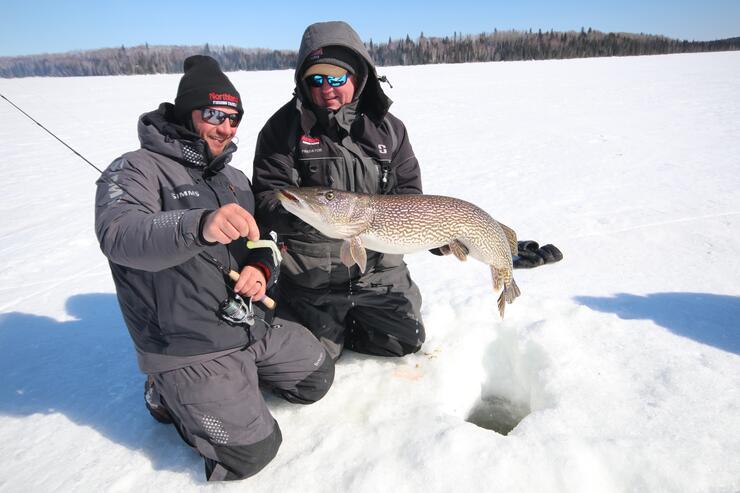“Flag!”
I looked up and decided I wasn’t going to make it for this one. Sean McAughey, one of my fishing pals was in a foot race with Ian Cooke, the owner of Fives Lake Lodge in the Red Lake area, for a flag that had just flown from a tip-up. The flag up was indicating a bite from a pike, probably another big one. Cooke, who has grown up in the Red Lake area was hosting us for a late March ice fishing trip and we were catching big pike one after the other. It’s some of the most fun you’ll ever have on the ice.

Where to find pike
All ice anglers need to understand that northern pike spawn shortly after ice-out and that puts pike, especially the big ones, in predictable locations late in the ice season. In Northwest Ontario, our pike season is open year-round so we can fish pike as late as the ice allows us to get out there.
Earlier in the winter, pike can be found shallow, deep, and in between. Years ago I started putting out cisco on a tip-up as my second line throughout the winter while walleye fishing. You will run into big pike quite often while fishing the same humps that we fish for walleyes. It’s not that consistent but every other trip we’ll catch a big fish so it’s worth putting a line out.
If you’re serious about catching pike, both big ones and numbers, you want to concentrate your fishing efforts in March when these fish start congregating in front of the shallow weed-filled bays where they will spawn shortly after ice out. When I describe choosing a location, I always tell people that I like to fish at the first drop into deeper water. Usually, this is when you go from six or eight feet of water out to that fifteen to twenty range. It’s all relative to the water you’re fishing. On some of the shallow, tannic-colored lakes, you might be fishing shallower. That part of it you have to figure out by dropping some lines.
Luckily, pike will let you know fairly quickly most days if they are around. I think if you have a point or piece of structure to drill holes around, that’s okay, but flats are fine too. These fish obviously have some pretty good senses because they’ll sniff out those frozen dead baits fairly quickly when you put them down there. If I fish a spot for an hour and don’t get any hits, I’m moving to a different area.
If I’m fishing some new water I’ll usually drill holes in a variety of depths and then see where most of the bites come from. Some flats are massive so your holes will all be the same depth so you just try and see if you get bites. After a couple of trips to a body of water, I usually have a good idea of the best depth to focus on.
The good news for anglers is most waters across the region hold pike and most of the bigger lakes have plenty of big ones. Find a shallow bay, set up at the mouth of it and you will probably catch a bunch of fish. Most of my experience has been on Lake of the Woods because it’s where I’ve grown up and we have so many good fishing options so it’s tough to go anywhere else.
Most of the biggest pike I’ve ever caught have been out there in March. Last year was my first time heading north to fish with Cooke in the Red Lake area and that was next-level fishing. Seven of us went and in two days, everybody caught multiple pike over 40”. It was a time! The advantage of booking a trip with a guide or through a resort that stays open in the winter is that you’ll be able to get out with someone who knows where you can catch fish and knows where the safe ice is. As a general rule, the farther north or more remote you go, the better the fishing for big pike.
How to catch pike through the ice
In Ontario, we are allowed to use two lines for ice fishing. Before I truly knew the effectiveness of tip-ups and dead baits, I used to jig a lure on one rod and use a tip-up for my second line. We actually do this a lot when we jig for walleye, put the tip-up down for the second line, but if you are trying to only target pike, get your group a bucket full of tip-ups.
While you can catch pike jigging with lures, your chances of catching the big ones greatly diminish. Trust me, I’ve spent days and days jigging lures for walleyes and you catch the incidental pike here and there, the odd good one, but not nearly as many as you’ll get on dead baits. Jig in prime pike water and the numbers go up a little bit but again if you want to catch numbers of big pike, set up a flag.
Getting good bait can be the most challenging part but again this is where the resort owners or guides might be able to help you out. We catch a lot of our own bait – sucker minnows in creeks in the spring or we’ll catch ciscos, which are my favourite bait, while we ice fish in the winter. We run into the ciscos while lake trout fishing and sometimes when we’re crappie fishing.
They’ll cruise by, oftentimes suspended and if you can get a small spoon down them, they’ll usually bite. They are aggressive little guys. The best bait size for a pike is eight to ten inches in the length. Big, but not too big. Bait shops will have frozen cisco and sucker minnows but often they are smaller-sized baits, which still work, but not as well.
The setup is pretty simple. You need some tip-ups. I like the kind that covers the hole to help keep it from freezing quite as quickly and they’ll keep blowing snow out of it. For line, if you can find some tip-up line, it’s soft and has some stretch so it’s not too hard on the hands. If you can’t find the good tip-up line, I’ve been using an 80 lb braid and it works fine, you just need to be careful not to wrap it around a finger if you’re fighting a big fish, it’ll cut you. I just tie the braid directly to the quick-strike rig.
I have been using the Northland Predator Rig for years, they are easy to find and are built well. I also make my own rigs. They are easy to make with both heavy fluorocarbon and wire. I like two hooks on the rig, one goes in the head of the bait, the other at the dorsal fin. I’m big on trying to get the bait to sit horizontally in the water when it’s hanging but I have friends who use in-line rigs where the bait sits nose down and they say it doesn’t matter.
When you get a bite, I like to let the pike make its initial run and then hit them when they start to slow down. If it’s a big one, they’ll usually get it in their mouth when they bite it and you can hit them, don’t wait too long or you risk the fish swallowing the bait and their chances of survival go down. I like to set the bait about a foot above the bottom.
One more tip you need to know. The baits will float so you need to take a knife and poke a few holes in them to release all of the air from the air bladder. Poke a few holes, then squeeze the bait in the hole and you’ll see the air come out. When you get all the air out of the bait, it will sink relatively quickly.
Finally, we’ve tried live baits on these rigs but for some reason, the dead baits are the best. Again, trust me on that one! Don’t forget to bring tools out on the ice as well, they are mandatory for dealing with big pike. Long-nosed pliers, hook cutters, and jaw spreaders.
Sometimes on the really good days, our pike trips turn into a full-contact sport as we race each other to the flags when they go off. It’s a lot of fun catching these big critters and late ice is when you see the biggest ones of the year. Ontario’s Sunset Country Region is as good as it gets for pike on the ice.









